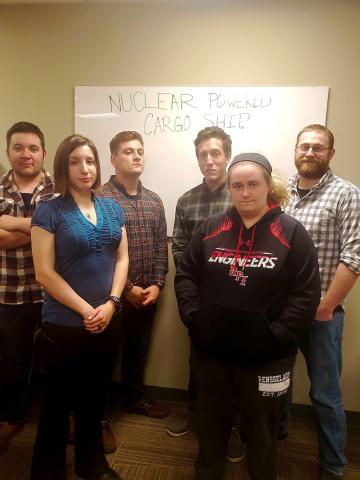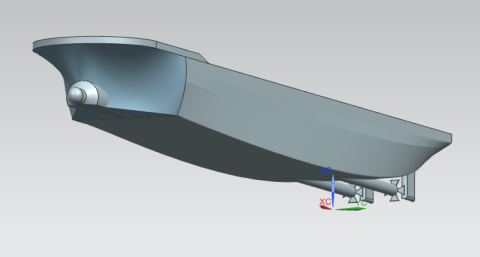The goal of this project is to generate an implementable design for a nuclear-powered cargo ship through the consolidation of preexisting ships and nuclear reactors. After a considerable amount of work, the group has come to the conclusion that a Maersk Triple-E class cargo ship would be a suitable vessel that could be easily powered by two 60-MW NuScale power modules. These two reactors will power a ship that, when fully loaded, can carry up to 18000 containers.
Team: Jason Aman, Emre Kulahlioglu, Angie Picard, Greg Rudshtein, Ernest Sacco, Madeleine Waller
Project Advisor: Dr. Spencer Scott

Members of the design group
Project Motivation
With pollution levels constantly rising, it is imperative that humanity takes every possible precaution to stop or reverse the accompanying environmental damage. Nautical cargo shipping is an easy target in that regard, since it not only produces a myriad of pollutants from bunker fuel, but also has feasible eco-friendly alternatives. While research into past nuclear powered cargo ships has shown that they have failed, further research has shown that a nuclear powered cargo ship, through proper design, regulatory adherence, and international policy observance, could be a solution to the pollution caused by nautical shipping.

Goossens, R. (2018). N.S. Savannah - a nuclear-powered passenger-cargo ship. [Online]. Ssmaritime.com. Available at: http://www.ssmaritime.com/NS-Savannah.htm
Project Description
The goal of this project is to generate an implementable design for a nuclear-powered cargo ship through the consolidation of preexisting ships and nuclear reactors. After a considerable amount of work, the group has come to the conclusion that a Maersk Triple-E class cargo ship would be a suitable vessel that could be easily powered by two 60-MW NuScale power modules. These two reactors will power a ship that, when fully loaded, can carry up to 18000 containers.

Goossens, R. (2018). N.S. Savannah - a nuclear-powered passenger-cargo ship. [Online]. Ssmaritime.com. Available at: http://www.ssmaritime.com/NS-Savannah.htm
Results and Accomplishments
Based on the Maersk Triple-E class NPM design, further research was conducted to approximate the crew needed for the ship. The current average size of a container ship crew is 28 personnel. Since a reactor is placed onboard the ship, this number is expected to grow by three people to 31 personnel. This number is based on the the following documents, which state that Small Modular Reactors are staffed on a case by case basis and on current reactors of similar types: 10CFR50.54, SECY-11-0098, and IAEA-TECDOC-1193. Elaboration on the concepts vital to these documents can be found in chapter 18 of NUREG-0800. This increase in staffing comes with a cost. Based on salary levels of crew in the market, the approximate yearly cost to salary to crew salary is $2.3 million. For non-nuclear career salaries, a 20% pay increase has been included in the calculation to represent the value of specialized knowledge the crew will need. The location of the reactor is essential to the safety of the ship, personnel, and the environment surrounding the ship. From analyzing current statistical data, the safest location for the reactor will be the aft end of the ship, behind the cargo. This decision was made based on the damage due to collisions, fires/explosions, and damage due to abnormal motions and vibrations. Finally, the cost of each container ship is approximated to be $190.6 million. This cost is based on the value of a contract for 10 Maersk Triple-E class ships purchased for a cost of $1.9 billion. An additional cost of $600,000 for the NPM reactors further increases the price. Although the bi-yearly cost of fuel is still being determined, the cost of fully replacing the reactors every refueling cycle is being considered against the price of a single voyage from Los Angeles to China for purposes of comparison. This cost of replacement is the same as the cost of the reactor at $600,000. To put the worst possible scenario cost of refueling into perspective, the average cost for fuel on a fully laden voyage from Los Angeles to China is approximately $668,000. Thus it is strongly believed that the use of nuclear reactors will lead to a net savings in operations and maintenance costs.